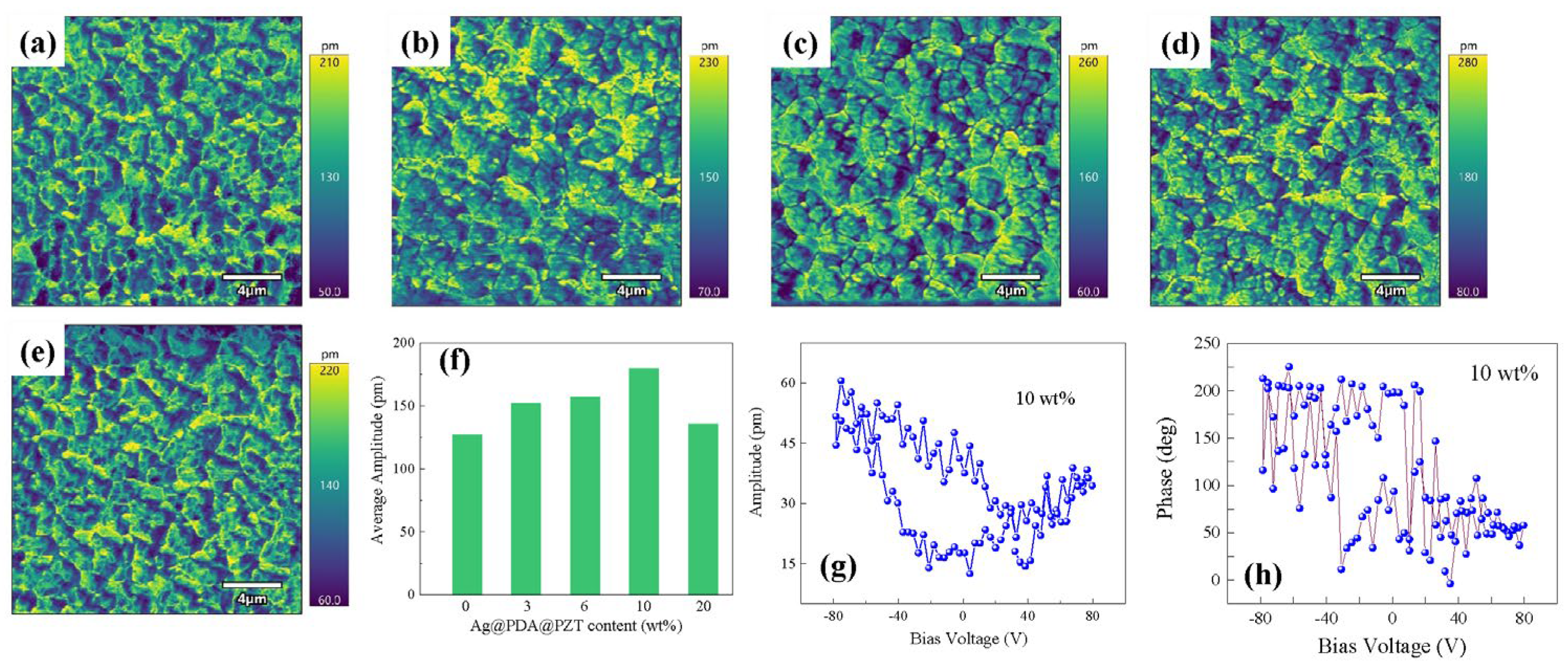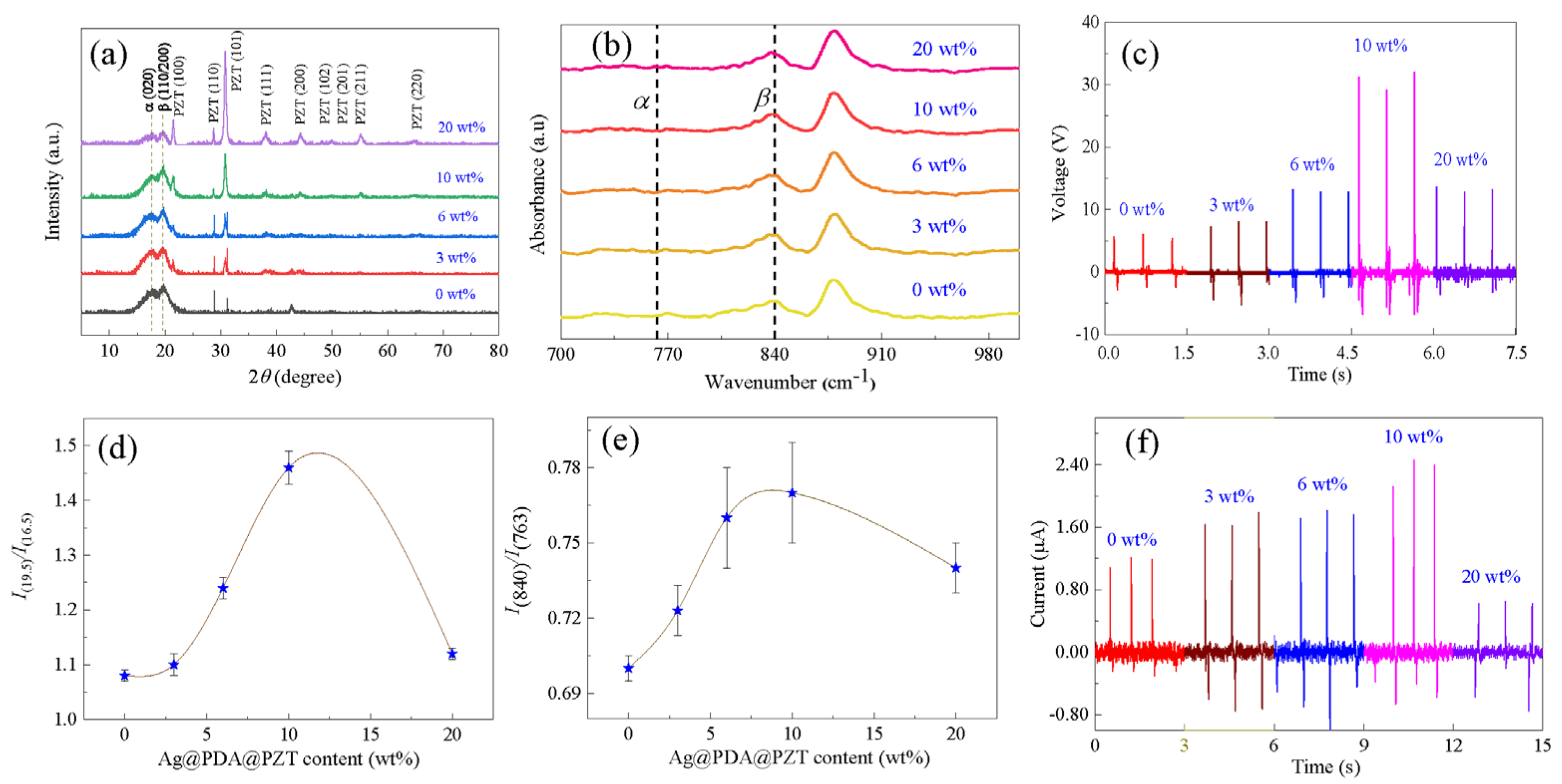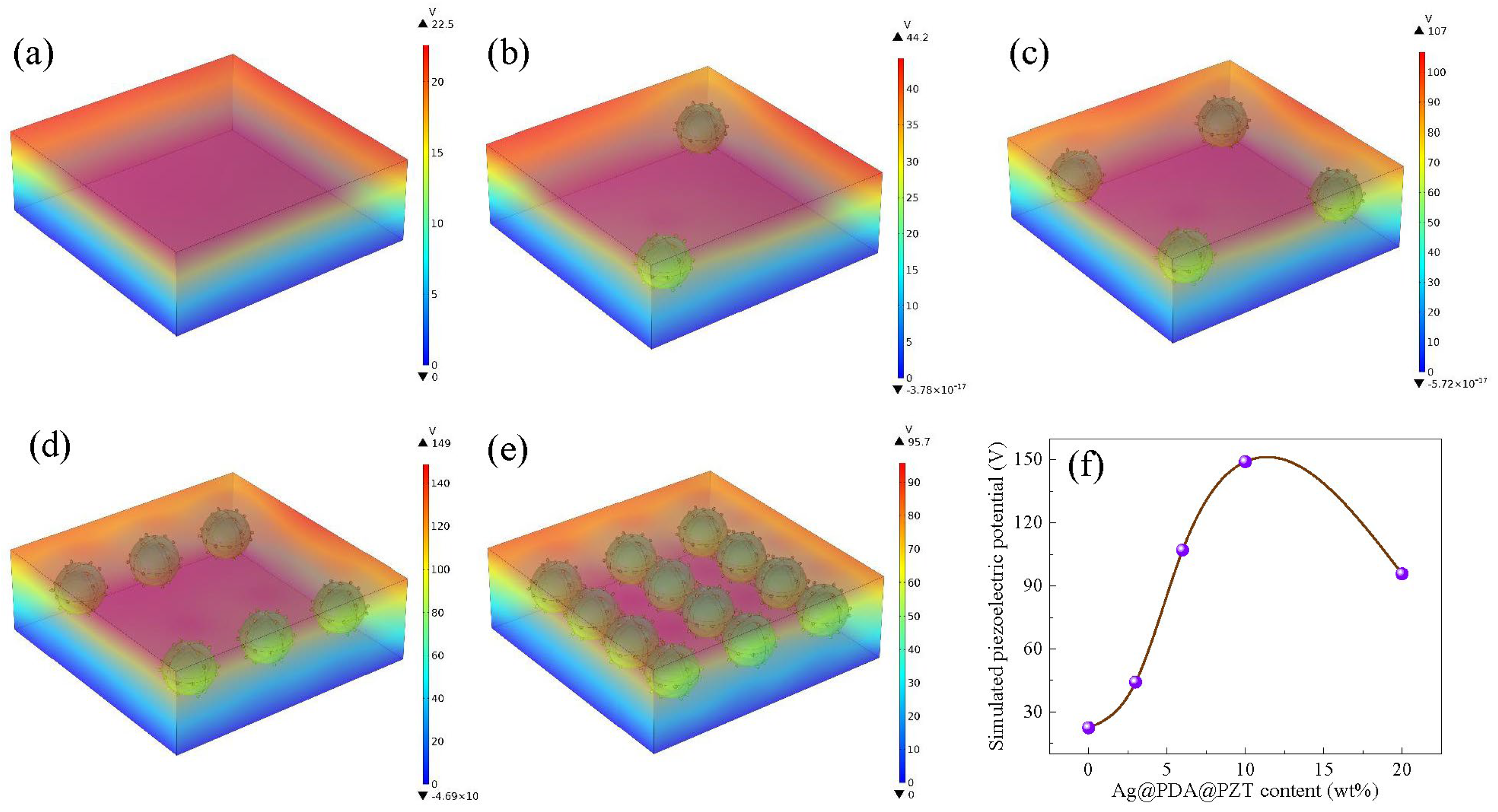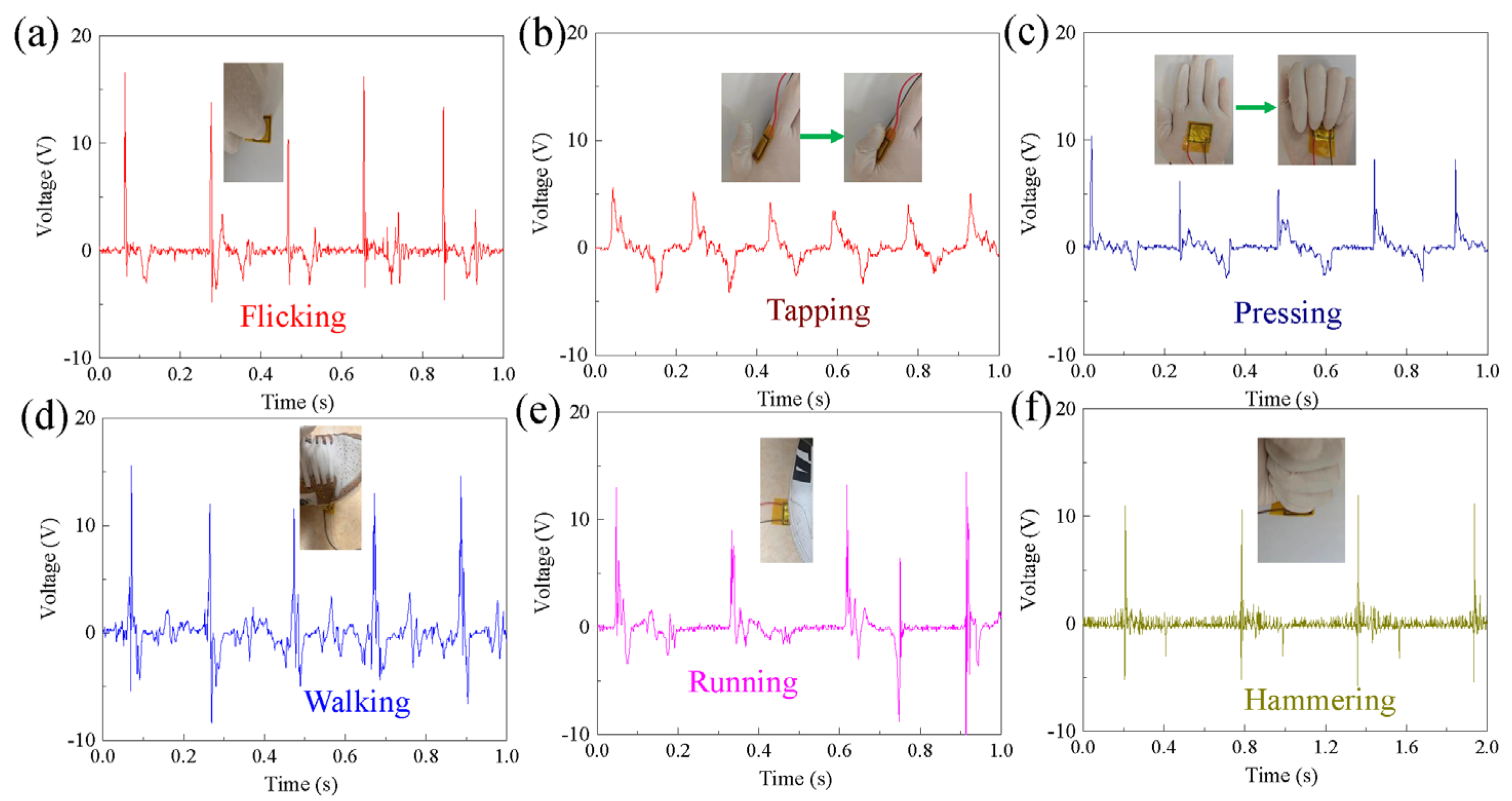Flexible Pressure Sensors Based on P(VDF-TrFE) Films Incorporated with Ag@PDA@PZT Particles
Abstract
:1. Introduction
2. Materials and Methods
3. Results
4. Discussion
5. Conclusions
Supplementary Materials
Author Contributions
Funding
Institutional Review Board Statement
Informed Consent Statement
Data Availability Statement
Conflicts of Interest
References
- Yuan, X.; Mai, Z.; Li, Z.; Yu, Z.; Ci, P.; Dong, S. A 3D-printing approach toward flexible piezoelectronics with function diversity. Mater. Today 2023, 69, 160–192. [Google Scholar]
- Yang, X.; Chen, W.; Fan, Q.; Chen, J.; Chen, Y.; Lai, F.; Liu, H. Electronic Skin for Health Monitoring Systems: Properties, Functions, and Applications. Adv. Mater. 2024, 36, 2402542. [Google Scholar]
- Das, K.K.; Basu, B.; Maiti, P.; Dubey, A.K. Piezoelectric nanogenerators for self-powered wearable and implantable bioelectronic devices. Acta Biomater. 2023, 171, 85–113. [Google Scholar]
- Kim, D.B.; Kim, J.Y.; Han, J.; Cho, Y.S. Strain engineering in power-generating and self-powered nanodevices. Nano Energy 2024, 125, 109551. [Google Scholar]
- Huang, Q.; Jiang, Y.; Duan, Z.; Wu, Y.; Yuan, Z.; Zhang, M.; Tai, H. Ion gradient induced self-powered flexible pressure sensor. Chem. Eng. J. 2024, 490, 151660. [Google Scholar]
- Stepancikova, R.; Olejnik, R.; Matyas, J.; Masar, M.; Hausnerova, B.; Slobodian, P. Pressure-Driven Piezoelectric Sensors and Energy Harvesting in Biaxially Oriented Polyethylene Terephthalate Film. Sensors 2024, 24, 1275. [Google Scholar] [CrossRef]
- Mohammadpourfazeli, S.; Arash, S.; Ansari, A.; Yang, S.; Mallick, K.; Bagherzadeh, R. Future prospects and recent developments of polyvinylidene fluoride (PVDF) piezoelectric polymer; fabrication methods, structure, and electro-mechanical properties. RSC Adv. 2023, 13, 370–387. [Google Scholar]
- Liu, F.; Hashim, N.A.; Liu, Y.; Abed, M.R.M.; Li, K. Progress in the production and modification of PVDF membranes. J. Membr. Sci. 2011, 375, 1–27. [Google Scholar]
- Zhou, J.; Xu, L.; Zhang, L.; Zhang, J.; Zhang, A. Electrospun Polyvinylidene Fluoride Nanogenerator with Hydrophobic Properties and Enhanced Energy Harvesting for Wearable and Wireless Sensing. ACS Appl. Electron. Mater. 2024, 6, 2026–2038. [Google Scholar]
- Zhang, F.; Wang, G.; Lin, N.; Zhou, J.; Zhong, S.; Yuan, M.; Li, B.; Zhou, W. Synergistic promotion of inter-particle and intra-particle polarizations in BST@TiO2/PVDF nanocomposites towards elevated dielectric properties. Compos. Sci. Technol. 2024, 251, 110547. [Google Scholar]
- Yao, H.; Xia, Z.; Wang, J.; Lin, H.; Yang, H.; Zhang, Q. Porous, Self-Polarized Ferroelectric Polymer Films Exhibiting Behavior Reminiscent of Morphotropic Phase Boundary Induced by Size-Dependent Interface Effect for Self-Powered Sensing. ACS Nano 2024, 18, 9470–9485. [Google Scholar] [PubMed]
- Wu, B.; Yang, Y.; Wang, L.; Xu, H.; Huang, Y.; Kang, J.; Xiong, Y.; Yin, K.; Nie, M.; Sun, L. SnO2 induced electrostatic polarization PVDF composite nanofibers for efficient energy harvesting and self-powered wireless monitoring /motion recognition systems. Chem. Eng. J. 2024, 495, 153483. [Google Scholar]
- Park, C.; Lim, W.; Joshi, B.; Kim, T.; Samuel, E.; Aldalbahi, A.; Periyasami, G.; Ding, B.; Yoon, S.S. Enhancing the piezoelectric coefficient of SrTiO3 nanocubes and PVDF film deposited by supersonic spraying for energy-harvesting nanogenerators. Chem. Eng. J. 2024, 491, 151945. [Google Scholar]
- Mahanty, B.; Ghosh, S.K.; Prasad, G.; Shanmugasundaram, A.; Lee, D.-W. Giant Energy Harvesting via Maxwell Displacement Current Enhancement Using Metal Sheet Interspaced Hetero-Layer Structured Piezo-Composite Nanofiber Device. Adv. Funct. Mater. 2024, 34, 2307723. [Google Scholar]
- Joshi, B.; Kim, T.; Lim, W.; Samuel, E.; Park, C.; Aldalbahi, A.; El-Newehy, M.; Lee, H.-S.; An, S.; Yoon, S.S. Beta-phase transformation of polyvinylidene fluoride with supersonically sprayed ZnSnO3 cuboids for flexible piezoelectric nanogenerators. J. Mater. Sci. Technol. 2024, 177, 103–113. [Google Scholar]
- Huan, Y.; Zhang, X.; Song, J.; Zhao, Y.; Wei, T.; Zhang, G.; Wang, X. High-performance piezoelectric composite nanogenerator based on Ag/(K,Na)NbO3 heterostructure. Nano Energy 2018, 50, 62–69. [Google Scholar]
- Sasmal, A.; Seetharaman, A.; Maiti, P.; Sudhakar, S.; Arockiarajan, A. Charge-defect tuned PVDF based ternary biocompatible composite as skin touch actuated single electrode triboelectric nanogenerator for wireless healthcare monitoring. Chem. Eng. J. 2024, 487, 150573. [Google Scholar]
- Xia, J.; Lu, H.; Chen, G.; Lin, D.; Yang, W.; Liu, C.; Hu, B.; Zhao, Y. High performance piezoelectric nanogenerator by fiber microstructure engineering toward self-powered wireless sensing system. Nano Energy 2024, 128, 109901. [Google Scholar]
- Cui, Y.; Zhang, T.; Feng, Y.; Zhang, C.; Chi, Q.; Zhang, Y.; Chen, Q.; Wang, X.; Lei, Q. Excellent energy storage density and efficiency in blend polymer-based composites by design of core-shell structured inorganic fibers and sandwich structured films. Compos. B Eng. 2019, 177, 107429. [Google Scholar]
- Huan, Y.; Wei, T.; Wang, Z.; Shen, H.; Lin, X.; Huang, S.; Wang, X. Ultrahigh energy harvesting properties in Ag decorated potassium-sodium niobite particle-polymer composite. J. Mater. 2020, 6, 355–363. [Google Scholar]
- Shuai, C.; Liu, G.; Yang, Y.; Qi, F.; Peng, S.; Yang, W.; He, C.; Wang, G.; Qian, G. A strawberry-like Ag-decorated barium titanate enhances piezoelectric and antibacterial activities of polymer scaffold. Nano Energy 2020, 74, 104825. [Google Scholar]
- Sasmal, A.; Patra, A.; Devi, P.S.; Sen, S. Space charge induced augmented dielectric permittivity and improved energy harvesting ability of nano-Ag decorated ZnSnO3 filled PVDF based flexible nanogenerator. Compos. Sci. Technol. 2021, 213, 108916. [Google Scholar]
- Qin, W.; Zhou, P.; Xu, X.; Huang, C.; Srinivasan, G.; Qi, Y.; Zhang, T. High-Performance Piezoelectric Nanogenerator Based on Low-Entropy Structured Nanofibers for a Multi-Mode Energy Harvesting and Self-Powered Ultraviolet Photodetector. ACS Appl. Electron. Mater. 2022, 4, 2970–2978. [Google Scholar]
- Cao, C.; Zhou, P.; Wang, J.; Chen, D.; Huang, C.; Qi, Y.; Zhang, T. Enhanced energy harvesting performance via interfacial polarization in ternary piezoelectric composites for self-powered flexible pressure sensing application. Ceram. Int. 2023, 49, 22377–22385. [Google Scholar]
- Cao, C.; Zhou, P.; Wang, J.; Liu, M.; Wang, P.; Qi, Y.; Zhang, T. Ultrahigh sensitive and rapid-response self-powered flexible pressure sensor based on sandwiched piezoelectric composites. J. Colloid Interf. Sci. 2024, 664, 902–915. [Google Scholar]
- Wang, J.; Zhao, C.; Cao, C.; Liu, M.; Liu, Z.; Zhou, P.; Wang, G.; Zhang, T.; Qi, Y. Boosting Sensing Performance of Flexible Piezoelectric Pressure Sensors by Sb Nanosheets and BaTiO3 Nanoparticles Co-Doping in P(VDF-TrFE) Nanofibers Mat. Adv. Electron. Mater. 2023, 10, 2300718. [Google Scholar]
- Zhang, T.; Huo, X.; Wang, L.; Ma, F.; Hou, Y. Effectively improved energy storage performances of poly (vinylidene fluoride)-based nanocomposites via loading low fractions of TiO2@Fe3O4@ethylenediamine hybrid nanowires. J. Phys. D: Appl. Phys. 2023, 56, 435503. [Google Scholar]
- Hou, L.; Huan, Y.; Zheng, M.; Liu, Y.; Wang, C.; Wang, X.; Li, C.; Wang, Z.; Wei, T. 3D vertically aligned microchannel structure to enhance piezoelectric energy harvesting performance of PZT/PVDF&CNTs piezoelectric composites. J. Mater. 2024, 10, 1063–1070. [Google Scholar]
- Mukherjee, A.; Ghosh, B.D.; Roy, S.; Goh, K.L. Ultra strong flexible Ba0.7Sr0.3Zr0.02Ti0.98O3/MWCNT/PVDF Nanocomposites: Pioneering material with remarkable energy storage for Self-Powered devices. Chem. Eng. J. 2024, 488, 151014. [Google Scholar]
- Sasikumar, R.; Cho, S.; Waqar, A.; Ishfaque, A.; Choi, D.; Kim, B. Microcrack-assisted piezoelectric acoustic sensor based on f-MWCNTs/BaTiO3@PDMS nanocomposite and its self-powered voice recognition applications. Chem. Eng. J. 2024, 479, 147297. [Google Scholar]
- Yang, X.; Li, Y.; Guo, H.; Xiao, S.; Yuan, C.; Zhang, C.; Sun, H. Efficient energy harvesting enabled by large-area piezoelectric PVDF-based composite film enhanced by carbon nanotubes. Ceram. Int. 2024, 50, 12185–12194. [Google Scholar]
- Xu, H.; Xi, K.; Gao, X.; Yu, X.; Zheng, M.; Zhu, M.; Hou, Y. Flexible Hybridized Nanogenerators Based on a Reduced Graphene Oxide Nanosheet-Decorated Piezoceramic Skeleton to Impact Mechanical and Thermal Energy Harvesting. ACS Appl. Nano Mater. 2024, 7, 1120–1129. [Google Scholar]
- Song, Y.; Shen, Y.; Liu, H.; Lin, Y.; Li, M.; Nan, C.-W. Improving the dielectric constants and breakdown strength of polymer composites: Effects of the shape of the BaTiO3 nanoinclusions, surface modification and polymer matrix. J. Mater. Chem. 2012, 22, 16491–16498. [Google Scholar]
- Wang, J.; Fu, Y.; Liu, F.; Cao, C.; Liu, M.; Yu, L.; Zhou, P.; Shang, X.; Wang, G.; Zhang, T.; et al. Enhanced self-polarization effect by tuning interfacial binding energy for self-powered flexible piezoelectric pressure sensors. Sens. Actuat. A Phys. 2024, 374, 115473. [Google Scholar]
- Gu, W.; Zhao, B.; Yang, B.; Cai, Z.; Shang, X.; Zhou, T.; Guo, J. Achieving superior electrical properties of PZT-PNN piezoelectric ceramics through low-temperature sintering with PbO-CuO eutectic additives. J. Eur. Ceram. 2022, 42, 3831–3840. [Google Scholar]
- Zhao, J.; Zheng, M.; Gao, X.; Zhu, M.; Hou, Y. High-performance flexible piezocomposites based on an enhanced interfacial polarization effect via BCZT@Ag heterostructure design. J. Alloy Compd. 2024, 970, 172702. [Google Scholar]
- Thakur, P.; Kool, A.; Bagchi, B.; Hoque, N.A.; Das, S.; Nandy, P. Improvement of electroactive β phase nucleation and dielectric properties of WO3·H2O nanoparticle loaded poly(vinylidene fluoride) thin films. RSC Adv. 2015, 5, 62819–62827. [Google Scholar]
- Yadav, P.; Raju, T.D.; Badhulika, S. Self-Poled hBN-PVDF Nanofiber Mat-Based Low-Cost, Ultrahigh-Performance Piezoelectric Nanogenerator for Biomechanical Energy Harvesting. ACS Appl. Electron. Mater. 2020, 2, 1970–1980. [Google Scholar]
- Han, J.; Kim, D.B.; Kim, J.H.; Kim, S.W.; Ahn, B.U.; Cho, Y.S. Origin of high piezoelectricity in carbon nanotube/halide nanocrystal/P(VDF-TrFE) composite nanofibers designed for bending-energy harvesters and pressure sensors. Nano Energy 2022, 99, 107421. [Google Scholar]
- Liang, J.; Luo, J.; Zhang, J.; Xiong, Y.; Tan, S. Constructing a High-Density Thermally Conductive Network through Electrospinning–Hot-Pressing of BN@PDA/GO/PVDF Composites. ACS Appl. Polym. Mater. 2022, 4, 2414–2422. [Google Scholar]








Disclaimer/Publisher’s Note: The statements, opinions and data contained in all publications are solely those of the individual author(s) and contributor(s) and not of MDPI and/or the editor(s). MDPI and/or the editor(s) disclaim responsibility for any injury to people or property resulting from any ideas, methods, instructions or products referred to in the content. |
© 2024 by the authors. Licensee MDPI, Basel, Switzerland. This article is an open access article distributed under the terms and conditions of the Creative Commons Attribution (CC BY) license (https://creativecommons.org/licenses/by/4.0/).
Share and Cite
Mei, Y.; Cao, C.; Zhou, P.; Wang, J.; Liu, M.; Shang, X.; Jiang, J.; Qi, Y.; Zhang, T. Flexible Pressure Sensors Based on P(VDF-TrFE) Films Incorporated with Ag@PDA@PZT Particles. Sensors 2024, 24, 5415. https://doi.org/10.3390/s24165415
Mei Y, Cao C, Zhou P, Wang J, Liu M, Shang X, Jiang J, Qi Y, Zhang T. Flexible Pressure Sensors Based on P(VDF-TrFE) Films Incorporated with Ag@PDA@PZT Particles. Sensors. 2024; 24(16):5415. https://doi.org/10.3390/s24165415
Chicago/Turabian StyleMei, Yingzheng, Chuan Cao, Peng Zhou, Jianqiao Wang, Miaoxuan Liu, Xunzhong Shang, Juan Jiang, Yajun Qi, and Tianjin Zhang. 2024. "Flexible Pressure Sensors Based on P(VDF-TrFE) Films Incorporated with Ag@PDA@PZT Particles" Sensors 24, no. 16: 5415. https://doi.org/10.3390/s24165415




